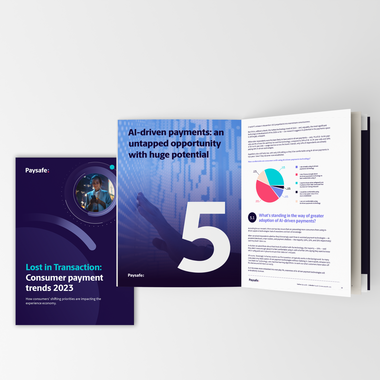AI in payments: consumer awareness and trust must grow to reach its potential
Jul 27, 2023
The potential for AI in payments is vast, and yet our recent Lost in Transaction report found that usage and appetite among consumers is low. So why is this the case, and how can this potential be realised?

AI has been one of the most discussed tech trends over the past decade, but awareness around its potential seems to have been supercharged by the arrival of ChatGPT in November 2022. Now, from AI-generated art winning prizes, to questions being raised around its impact on different industries, including film and TV, this is a trend that is no longer emerging – it has arrived, and is part of the popular consciousness.
For businesses, AI’s growing prominence among consumers can be good news. It boasts huge potential across almost every industry, from streamlining onerous manual processes, to improving customer personalisation, to delivering yet unheard-of benefits.
But despite the excitement, its potential in payments is still largely untapped by consumers –according to Lost in Transaction, only 14% of respondents state that they are already paying with AI-driven technologies.
Here’s what can be done to deliver upon the rich promise of AI in payments.
What’s the perception of AI-driven payments?
While AI has grabbed the attention of consumers around the world, appetite for its usage in payments is still low. Only 10% of respondents said they’d be comfortable using AI-driven payments in two years' time if they became more established.
As for why this is the case, our research found two key issues preventing more consumers from using AI-driven payment technologies: lack of awareness and lack of knowledge.
When we asked whether respondents had knowingly used three AI-assisted payment technologies — AI-powered checkouts, smart wallets, and payment chatbots — the majority (26%, 32%, and 31% respectively) said they hadn't done so.
Lack of awareness may not be entirely surprising. After all, in many situations, consumers encounter AI without realising it. Take Amazon Go's 'Just Walk Out' technology, for example, which uses machine learning algorithms to work out what customers have taken off the shelves and bill them correctly.
But this lack of known exposure to AI-driven payments may be impacting how the technology is perceived by consumers. When asked about their level of comfort with the technology, 35% of respondents didn't know enough to feel comfortable using it.
To ensure consumers warm to AI in payments as they have in other industries, more work must be done to drive awareness and build trust around its usage.
Businesses and consumers should embrace AI in payments
To deliver faster and more flexible payments, which benefit merchants and consumers alike, risk assessment must happen in real-time or near real-time. This means running necessary checks as fast and as smart as possible. AI can make this possible.
Payment providers integrate machine learning to help businesses achieve more effective fraud detection and increased authorisation rates. Through AI, huge amounts of transaction data can be evaluated for patterns such as time, frequency and value, for example, which wouldn’t be possible manually. But this is just scratching the surface of AI’s potential.
Put simply: by using AI, businesses can deliver better security and convenience for customers during the payment process.
Opportunity to grow awareness of AI in payments
By promoting the benefits of AI in payments, trust and awareness will likely grow among consumers.
And there are already green shoots of progress – about a third of our respondents know merchants use AI for risk scoring, fraud detection, and personalisation. In addition, 36% of respondents told us they know a lot or a fair amount about merchants using AI to analyse customer data, predict future payment trends, and personalise the payment experience.
By building awareness of the positive impact AI in payments can have for consumers and businesses, the more likely it is that we’ll see its vast potential realised, and even greater benefits discovered in the years ahead.
To find out more about consumer payment trends in 2023, check out our latest Lost in Transaction report.




